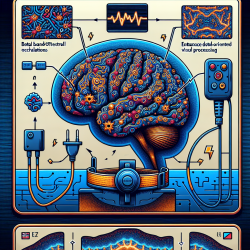As practitioners committed to improving outcomes for children with Autism Spectrum Disorder (ASD), staying informed about the latest research is crucial. One significant study titled Altered neural oscillations and connectivity in the beta band underlie detail-oriented visual processing in autism offers valuable insights that can inform our therapeutic approaches. This blog post aims to summarize the key findings and discuss their implications for practice.
Understanding Beta Band Oscillations in ASD
The study utilized electroencephalography (EEG) to investigate how detail-oriented visual processing in children with ASD is associated with altered neural oscillations and connectivity, specifically in the beta frequency band (15–30 Hz). This band is crucial for feedback and top-down signaling in the visual system.
Key Findings
- Children with ASD showed anomalous beta oscillatory activity during a visual crowding task, where they had to discriminate a peripheral target letter surrounded by flankers at different distances.
- Altered beta responses were linked to atypical functional connectivity between occipital areas (initial stimulus analysis) and infero-temporal regions (object identity extraction).
- This atypical beta connectivity predicted both ASD symptomatology and detail-oriented processing abilities.
Implications for Practice
These findings have several practical implications:
1. Targeted Interventions
Understanding that children with ASD exhibit altered beta oscillations can help us develop more targeted interventions. For instance, therapies that aim to enhance beta band connectivity could potentially improve detail-oriented visual processing.
2. Early Detection
Altered beta oscillations can serve as early markers for ASD, aiding in early diagnosis and intervention. Incorporating EEG assessments in early screening protocols could be beneficial.
3. Customized Therapy Plans
Given the variability in beta band connectivity among children with ASD, individualized therapy plans that consider each child's unique neural profile could be more effective. Practitioners should consider using EEG data to tailor interventions.
Encouraging Further Research
While this study provides valuable insights, further research is needed to fully understand the implications of altered beta band oscillations in ASD. Practitioners are encouraged to stay updated with ongoing research and consider participating in studies that explore these neural mechanisms further.
To read the original research paper, please follow this link: Altered neural oscillations and connectivity in the beta band underlie detail-oriented visual processing in autism.










